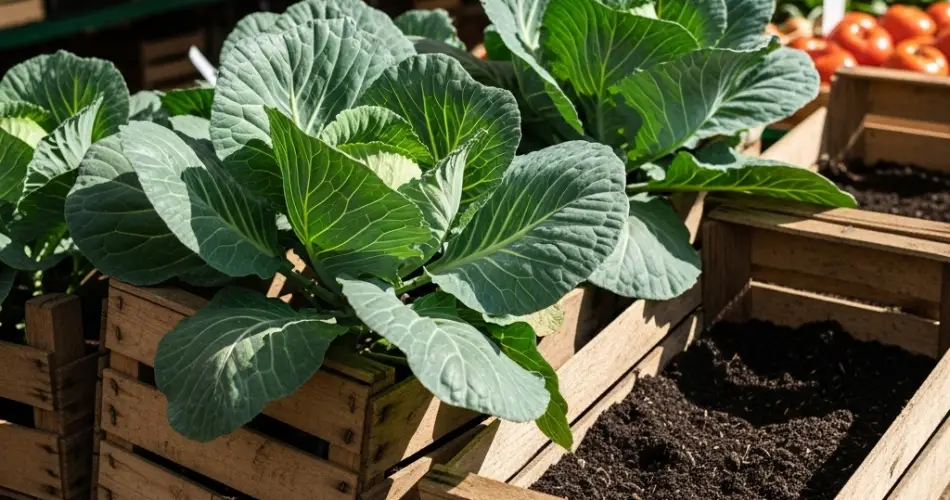Cabbage is a versatile, nutritious vegetable that can thrive in home gardens, and growing it in crates makes it accessible even for gardeners with limited space. Crate gardening allows you to control soil quality, drainage, and plant spacing, providing the ideal environment for healthy, robust cabbage heads. With proper care, even a small backyard or patio can yield impressive harvests.
Crates function like mini raised beds, offering advantages such as improved soil management, easier maintenance, and protection from some pests. Whether you are a beginner or an experienced gardener, growing cabbage in crates is both practical and rewarding.
Why Use Crates for Cabbage?
Growing cabbage in crates has several benefits:
-
Efficient Use of Space – Ideal for small yards, balconies, and patios.
-
Soil Control – Easily customize the soil mix to provide nutrients and good drainage.
-
Mobility – Move crates to optimize sunlight exposure or shelter plants during extreme weather.
-
Pest Reduction – Elevating plants reduces exposure to soil-borne pests such as slugs and snails.
-
Convenience – Crates keep plants contained, making watering, feeding, and harvesting simpler.
Selecting the Right Crates
To grow cabbage successfully, choose crates that are:
-
Deep – At least 12–16 inches to accommodate roots.
-
Spacious – Wide enough for one or more plants without crowding.
-
Sturdy and Untreated – Untreated wood avoids chemical contamination and ensures durability.
-
Well-Draining – Drill holes or use slatted designs to allow excess water to escape.
Lining crates with landscape fabric or burlap helps retain soil while still allowing water to drain efficiently.
Choosing Cabbage Varieties
Select varieties based on your space, climate, and harvest goals:
Compact Varieties (Best for Crates):
-
Golden Acre
-
Early Jersey Wakefield
-
Copenhagen Market
Larger Varieties (Need Bigger Crates):
-
Savoy
-
Green Globe
-
Red Drumhead
Compact, early varieties are ideal for small crates, while larger varieties can thrive if the crate is sufficiently deep and wide.
Materials Needed
-
Wooden crate (12–16 inches deep)
-
Nutrient-rich potting mix or garden soil with compost
-
Cabbage seedlings or seeds
-
Fertilizer or compost tea
-
Mulch (straw, shredded leaves, or grass clippings)
-
Sunny location with 6–8 hours of direct sunlight
Planting Cabbage in Crates
-
Prepare the Soil
Fill the crate with a well-draining, nutrient-rich soil mix. Cabbage prefers slightly acidic to neutral soil with a pH of 6.0–7.0. -
Transplanting Seedlings
Space cabbage seedlings 12–18 inches apart, depending on variety size. Plant them slightly deeper than they were in nursery pots to encourage strong root growth. -
Direct Sowing
For seeds, plant about ¼ inch deep. Once seedlings develop a few true leaves, thin them to ensure proper spacing and airflow.
Caring for Crate-Grown Cabbage
-
Watering – Keep soil evenly moist but not waterlogged. Consistent moisture prevents bitterness and supports head development.
-
Feeding – Fertilize every 2–3 weeks with a balanced fertilizer or compost tea to promote strong, healthy growth.
-
Mulching – Apply 2–3 inches of mulch to retain soil moisture, regulate temperature, and suppress weeds.
Monitoring growth and adjusting care as needed ensures optimal cabbage development.
Pests and Disease Management
Even in crates, cabbage can face challenges:
-
Cabbage Worms and Loopers – Handpick or use organic insecticidal sprays.
-
Aphids – Spray gently with water or insecticidal soap.
-
Fungal Issues – Ensure good airflow, avoid overhead watering, and rotate soil annually to prevent disease buildup.
Harvesting Cabbage
Cabbage is ready to harvest when heads feel firm and compact. Use a sharp knife to cut at the base, leaving outer leaves if you want potential regrowth for smaller secondary heads. Regular harvesting encourages the plants to direct energy into producing quality heads.
Extending the Growing Season
If cooler weather arrives early, crates can be moved to sheltered, warmer locations or protected with row covers. Cabbage tolerates light frost, but added protection helps extend the growing season and improve head quality.
Final Thoughts
Growing cabbage in crates is a simple, effective method for producing large, healthy heads in small spaces. Proper crate selection, nutrient-rich soil, and consistent care will result in bountiful harvests that are both convenient and visually appealing. Crate gardening combines practicality with charm, making it an excellent choice for home gardeners seeking maximum yield without needing a traditional garden plot.



